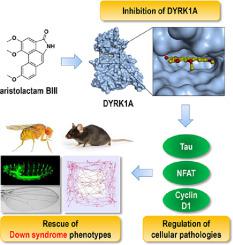Phytomedicine ( IF 7.9 ) Pub Date : 2021-08-01 , DOI: 10.1016/j.phymed.2021.153695 Miri Choi 1 , Ae-Kyeong Kim 2 , Youngwook Ham 3 , Joo-Youn Lee 4 , Daeyong Kim 3 , Ansook Yang 1 , Min Ju Jo 1 , Eunyoung Yoon 4 , Jung-Nyoung Heo 4 , Sang-Bae Han 5 , Min-Hyo Ki 6 , Kyu-Sun Lee 2 , Sungchan Cho 3

|
Background
Dual-specificity tyrosine phosphorylation-regulated kinase 1A (DYRK1A) is a significant pathogenic factor in Down syndrome (DS), wherein DYRK1A is overexpressed by 1.5-fold because of trisomy of human chromosome 21. Thus, DYRK1A inhibition is considered a therapeutic strategy to modify the disease.
Purpose
This study aims to identify a novel DYRK1A inhibitor and validate its therapeutic potential in DS-related pathological conditions.
Study design
In order to identify a novel DYRK1A inhibitor, we carried out two-step screening: a structure-based virtual screening of > 300,000 chemical library (first step) and cell-based nuclear factor of activated T-cells (NFAT)-response element (RE) promoter assay (second step). Primary hits were evaluated for their DYRK1A inhibitory activity using in vitro kinase assay and Tau phosphorylation in mammalian cells. Confirmed hit was further evaluated in pathological conditions including DYRK1A-overexpressing fibroblasts, flies, and mice.
Results
We identified aristolactam BIII, a natural product derived from herbal plants, as a novel DYRK1A inhibitor. It potently inhibited the kinase activity of DYRK1A in vitro (IC50 = 9.67 nM) and effectively suppressed DYRK1A-mediated hyperphosphorylation of Tau in mammalian cells. Aristolactam BIII rescued the proliferative defects of DYRK1A transgenic (TG) mouse-derived fibroblasts and neurological and phenotypic defects of DS-like Drosophila models. Oral administration of aristolactam BIII acutely suppressed Tau hyperphosphorylation in the brain of DYRK1A TG mice. In the open field test, aristolactam BIII significantly ameliorated the exploratory behavioral deficit of DYRK1A TG mice.
Conclusion
Our work revealed that aristolactam BIII as a novel DYRK1A inhibitor rescues DS phenotypes in cells and in vivo and suggested its therapeutic potential for the treatment of DYRK1A-related diseases.
中文翻译:

Aristolactam BIII,一种天然衍生的 DYRK1A 抑制剂,可挽救唐氏综合征相关表型
背景
双特异性酪氨酸磷酸化调节激酶 1A (DYRK1A) 是唐氏综合征 (DS) 的重要致病因子,其中 DYRK1A 由于人类 21 号染色体三体性而过度表达 1.5 倍。因此,抑制 DYRK1A 被认为是一种治疗策略改变疾病。
目的
本研究旨在鉴定一种新型 DYRK1A 抑制剂并验证其在 DS 相关病理状况中的治疗潜力。
学习规划
为了鉴定一种新型 DYRK1A 抑制剂,我们进行了两步筛选:基于结构的虚拟筛选 > 300,000 个化学库(第一步)和基于细胞的活化 T 细胞核因子(NFAT)反应元件( RE)启动子测定(第二步)。使用体外激酶测定和哺乳动物细胞中的 Tau 磷酸化来评估主要命中的 DYRK1A 抑制活性。在病理条件下进一步评估了确认的命中,包括过表达 DYRK1A 的成纤维细胞、果蝇和小鼠。
结果
我们将马兜铃内酰胺 BIII(一种源自草本植物的天然产物)鉴定为一种新型 DYRK1A 抑制剂。它在体外 有效抑制 DYRK1A的激酶活性(IC 50 = 9.67 nM) 并有效抑制 DYRK1A 介导的哺乳动物细胞中 Tau 的过度磷酸化。马兜铃内酰胺 BIII 挽救了 DYRK1A 转基因 (TG) 小鼠来源的成纤维细胞的增殖缺陷以及 DS 样果蝇模型的神经和表型缺陷。口服马兜铃内酰胺 BIII 可急性抑制 DYRK1A TG 小鼠大脑中的 Tau 过度磷酸化。在野外试验中,马兜铃内酰胺 BIII 显着改善了 DYRK1A TG 小鼠的探索性行为缺陷。
结论
我们的工作表明,马兜铃内酰胺 BIII 作为一种新型 DYRK1A 抑制剂可以挽救细胞和体内的DS 表型,并表明其治疗 DYRK1A 相关疾病的治疗潜力。



























 京公网安备 11010802027423号
京公网安备 11010802027423号